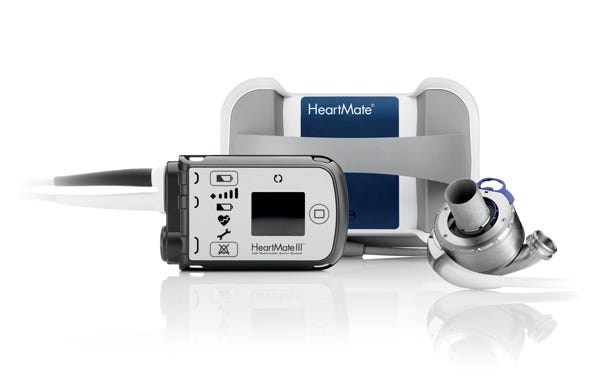Next Generation LVAD Receives CE Mark
October 12, 2015
The HeartMate 3 uses magnetic levitation of the device's rotor to prevent trauma to blood passing through the pump--a problem with previous models.
Chris Newmarker
|
The HeartMate 3 should hopefully address some of the problems such as pump thrombosis seen in previous LVADs. (Image courtesy of St. Jude Medical) |
The HeartMate 3 Left Ventricular Assist System--which St. Jude Medical acquired through its $3.3 billion purchase of Thoratec last week--has received CE Mark approval, the company said Monday.
The device "has been proven through the HeartMate 3 CE Mark study to show high survival rates, material improvements in functional status, and very low adverse event rates highlighted by zero pump thrombosis events," Eric Fain, MD, group president at St. Jude Medical, said in a news release.
"Heart failure remains one of the most costly epidemic diseases in the world, and the HeartMate 3 system is critical to supporting physicians managing the care of patients battling such a complex and challenging condition," Fain said.
The HeartMate 3 should hopefully address some of the problems U.S. FDA has noticed with LVADs. Since FDA approval of the devices, there has been an increased rate of pump thrombosis (blood clots inside the pump) among people using Thoratec's HeartMate II, and a high rate of stroke among people using the HeartWare HVAD, FDA says.
At the same time, FDA officials still maintain that the benefits of LVADs outweigh the risks when it comes to saving the lives of people with advanced left ventricular heart failure. By supplementing the pumping function of the heart for people whose hearts are too weak to do so on their own, the small, implantable devices can provide a bridge for people waiting for a heart transplant, or a final option for those who do not qualify for transplants.
St. Jude is touting the HeartMate 3 as the first commercially approved centrifugal-flow LVAD that uses fully magnetically-levitated technology. Magnetic forces suspend the device's rotor, a design meant to reduce trauma to blood passing through the pump.
The HeartMate 3 also includes artificial pulse technology meant to combat the formation of thrombus in the device.
"The advanced heart failure medical community has eagerly anticipated the expected clinical improvements with the HeartMate 3 system and looks forward to its broad adoption throughout Europe," said Friedhelm Beyersdorf, medical director of the cardiovascular surgery department at Freiburg University's Heart Center.
In the United States, the HeartMate 3 is part of an ongoing IDE trial enrolling more than 1000 patients.
Learn more about cutting-edge medical devices at Minnesota Medtech Week, November 4-5 in Minneapolis. |
Chris Newmarker is senior editor of Qmed and MPMN. Follow him on Twitter at @newmarker.
About the Author(s)
You May Also Like



